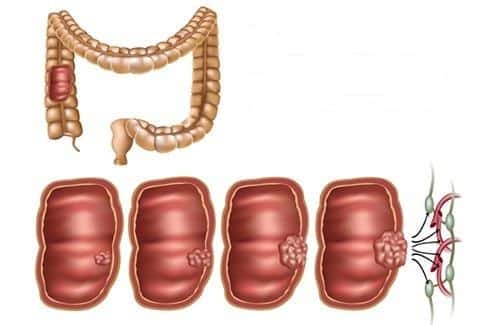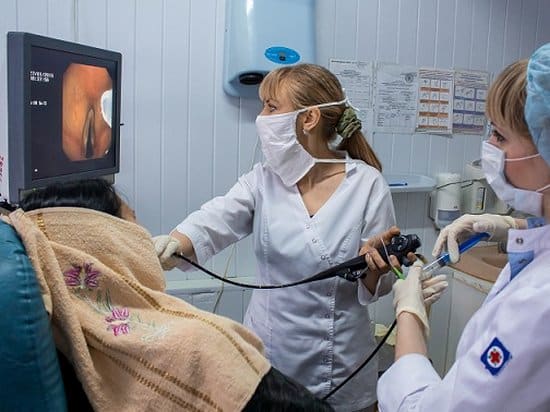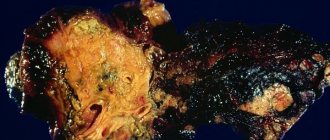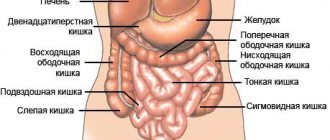Stages of intestinal cancer - specialists in the field of gastroenterology distinguish four degrees of severity of the course of such an oncological process. However, this also includes a precancerous condition.
- Zero degree
- initial stage
- Moderate stage
- Severe stage of progression
- Complicated course
Three underlying factors will differ depending on the stage of disease progression. These include:
- presence and severity of clinical manifestations;
- treatment regimen;
- five-year survival prognosis.
The insidiousness of the pathology lies in the fact that it can be completely asymptomatic for a long time, and if clinical signs are expressed, they are often nonspecific, i.e., they are characteristic of a wide range of ailments of the digestive system.
It is worth noting that not only the clinical picture is a determining factor in the degree of development of rectal cancer. Instrumental diagnostic measures, which are similar for all stages of the course of such a disease, can confirm the clinician’s guesses and doubts.
What is bowel cancer?
Colon cancer is a malignant degeneration of the glandular epithelium, mainly of the colon or rectum. The first stages are characterized by sluggish symptoms, distracting from the primary pathology and reminiscent of a gastrointestinal disorder. The leading radical treatment method is surgical excision of the affected tissue.
Epidemiology
In official medicine, intestinal cancer is referred to as “colorectal cancer.” This is a collective name consisting of two roots: “colon” and “rectum”. It is in the corresponding parts of the intestine that the maximum number of primary malignant tumors is detected.
Colon (lat. colon) is a colon with four consecutive sections:
- ascending, which is located vertically on the right side of the human body;
- descending - vertically on the left side;
- transverse - connects the ascending and descending sections, located in the upper part of the abdominal cavity, just below the stomach and liver;
- sigmoid - forms a peculiar short bend in the form of a letter (Σ), is located at the bottom on the left side and connects the descending and rectum.
Rectum (lat. rectum) is the rectum (located in the pelvis).
In the cecum and appendix (third section of the large intestine) and small section (duodenum, jejunum, ileum), malignant neoplasms are much less common. The average incidence of cancer detection outside the large intestine is 0.4-1.0% of all cases of intestinal oncology.
Important epidemiological features of colon cancer:
- occupies a leading position in the structure of oncological diseases, inferior to: in men – stomach cancer and lung cancer, in women – breast cancer;
- the most common morphological form of this cancer is adenocarcinoma (malignant degeneration of benign intestinal polyps consisting of glandular tissue);
- the probability of developing adenocarcinoma in the intestine is 98-99%, the incidence of sarcoma and other types of tumors does not exceed 1-2%;
- the most common location of the tumor: in the rectum (about 50%), in the sigmoid colon (up to 40%), in the descending and ascending colon (about 7%), in the transverse colon (about 3%);
- Women are more often (up to 55%) diagnosed with cancer of the colon, and men (up to 60%) are diagnosed with cancer of the rectum;
- The disease occurs at any age, a sharp rise in incidence is observed after 40 years, the peak occurs in the period from 60 to 75 years.
In Russia, about 40 thousand cases of colorectal cancer are diagnosed annually with a mortality rate of up to 30 thousand. High mortality is associated with the health status of older people, who almost always have comorbidities.
The paradox is that colorectal cancer is not a pathology with difficult to detect symptoms. This disease can be detected by modern instrumental and laboratory methods even at the earliest stages, but it is characterized by a significant number of diagnostic errors associated with the multiplicity of clinical manifestations of the disease.
In this regard, it is very important:
- qualifications and oncology alertness of doctors performing the initial appointment at the district clinic;
- attentiveness of patients (especially older and older people) suffering from gastrointestinal disorders and those at risk of colorectal cancer.
Diagnosis of any disease, and especially in the early stages, is always a dialogue between the doctor and the patient. Very often, information from a patient who correctly describes the signs of a disease is crucial.
However, patient alertness is not the main link in timely diagnosis of cancer for the following reasons:
- A doctor conducting an appointment at a clinic may not pay attention to signs of oncology in a stream of patients. Its symptoms are varied, perhaps erased, especially since increased fatigue, weight loss, diarrhea, blood in the stool, discomfort or pain in the abdomen, rapid heartbeat (the main signs of the first stages) resemble many diseases, and are effectively, albeit temporarily, eliminated medicines.
- It is sometimes psychologically difficult for a local therapist to replace a previously made diagnosis associated with a banal chronic digestive disorder with a frightening one - cancer, and promptly refer the patient to a specialist for a highly sensitive examination;
- Only the patient knows about his own predisposing risk factors for oncology in the form of similar diseases in blood relatives, the characteristics of his personal lifestyle, the nature of his work, nutrition, and the presence of some individual delicate symptoms.
The knowledge gained within the framework of this educational article will help the average person understand the causes of the disease to the extent sufficient to draw the attention of the clinic doctor to this problem during the initial appointment.
Cancer is not always a death sentence! This is a situation where it is better to make a mistake in guessing a formidable diagnosis than to mistakenly make a banal diagnosis. For timely detection of pathology, a prepared patient is needed who does not become depressed just from the suspicion of oncology in his body.
Colorectal cancer: can it be avoided?
To prevent colorectal cancer (as well as other types), it is very important to be attentive to your body, pay attention to strange symptoms, and also lead a healthy lifestyle.
Nowadays, there are no methods of preventing cancer that would give a 100% guarantee. Therefore, everything is in our hands, we must try to treat our body with maximum attention and care.
Now we will give some recommendations to help you with this:
- If you smoke, don’t delay it, but say goodbye to this bad habit as soon as possible.
- The Mediterranean diet will benefit your health: more fruits, fresh vegetables and olive oil.
- Cleanse your colon regularly. So, it is recommended to start the morning with a glass of warm water with lemon or a spoon of olive oil with the addition of a few drops of lemon juice. Another good alternative is aloe vera tea.
- Include probiotics in your diet to support healthy gut bacterial flora.
- Infusions of ginger and mint in the evening will also benefit your intestinal health.
- Drink one liter of artichoke broth twice a week, as this vegetable has healing properties.
- Try to avoid stressful and anxious situations.
- Regular exercise will also benefit your body. For example, taking a daily hour-long walk can be a great habit.
Polyps in the large intestine: main symptoms Often, the presence of polyps in the large intestine is detected by chance during other tests. Why are polyps dangerous? Is it possible to prevent their occurrence and how? Read more "
Symptoms of bowel cancer
Diagnosing cancer based only on clinical symptoms is futile due to the numerous manifestations of the disease. The following description of symptoms is given to show the variety of manifestations of pathology, and to confirm the importance of competent medical diagnosis using modern methods.
Colorectal cancer has no characteristic (pathognomonic) symptoms. There are several groups of symptoms of intestinal cancer that characterize various pathological processes within the patient’s body.
Toxic-anemic symptoms
The initial stages of intestinal cancer are accompanied by a violation of the integrity of the mucous membranes of the intestinal walls.
As a result, the gates of infection open, the contents of the intestines enter the blood, causing intoxication, which manifests itself:
- increased fatigue, weakness, headache, nausea, and other signs of intoxication;
- elevated body temperature, joint pain (a consequence of toxicosis);
- loss of blood from small vessels of the intestinal wall, anemia, pallor of the mucous membranes, decreased hemoglobin levels, thickening of the blood, changes in its other indicators and, as a result, changes in the rhythm of the heart and breathing.
The disease can be confused with a variety of intoxications caused, for example, by inflammatory diseases of the heart, joints or upper respiratory tract.
Enterocolitic inflammation of the large intestine: symptoms
This inflammation is formed mainly with extensive damage to the mucous membranes, when toxins begin to enter the blood from the surface of the damaged membranes, and in addition to intoxication, intestinal dysfunction occurs.
Pathology manifests itself:
- increased body temperature, reminiscent of an infectious fever;
- constipation and more often - diarrhea;
- increased gas formation as a result of rotting intestinal contents, bloating and rumbling;
- involvement in the pathogenesis of intestinal sphincters that regulate peristalsis. The process is accompanied by periodic pain in the abdomen (left or right), especially after eating;
- mucus, visible blood and pus in the stool.
In the absence of oncological alertness, the doctor may confuse these symptoms with dysentery, inflammatory processes in the large intestine.
Dyspeptic bowel disorder: symptoms
This disorder is detected when a large number of pain receptors are involved in the pathogenesis and irritation as a result of ulceration of the walls of the mucous membranes, as well as in the initial stages of metastasis to the liver.
Symptoms appear as:
- severe abdominal pain;
- unpleasant belching is a sign of damage to the sphincters and liver;
- nausea and vomiting – toxemia;
- diarrhea or constipation - impaired intestinal motility;
- elevated body temperature.
Dyspeptic intestinal disorder resembles an inflammatory process in the appendix (this is part of the large intestine), as well as in organs adjacent to or functionally associated with the large intestine (pancreas, stomach, small intestine, gall bladder).
Obstructive blockage of the intestinal lumen: symptoms
Blockage is detected when the tumor metastasizes and the formation of inflammatory adhesions around it.
The pathology usually manifests itself as signs of partial blockage of the lumen of the colon in the form of:
- prolonged constipation that is not eliminated by enemas and laxatives;
- heaviness in the stomach;
- increased pain after eating.
Signs of blockage resemble diverticulosis (formation of pockets filled with feces in the intestinal walls), adhesive disease, spastic pain in the intestines, the presence of fecal stones (calculi) in the lumen of the rectum.
When the small intestine is involved in carcinogenesis, symptoms of acute and complete intestinal obstruction, intussusception (protrusion of the walls), and volvulus are formed. These phenomena are manifested by severe pain, uncontrollable vomiting, sometimes immediately after eating, and the rapid development of cancer symptoms.
Pseudo-inflammatory (resembling general inflammation) symptoms
They develop in the later stages of oncology with metastases to the lungs, ovaries, and other organs; very often the symptoms are combined with a palpable tumor.
The following signs of the disease are detected:
- heat;
- severe, constant pain in the abdomen, sometimes of unclear localization;
- purulent and bloody discharge from the anus during bowel movements;
- constipation, inability to defecate without an enema, difficulty evacuating intestinal gases;
- symptoms associated with organs affected by metastases, for example, cough when the lungs are involved, dyspepsia when the liver is involved, discharge from the genital organs when they are involved in carcinogenesis.
initial stage
An oncological lesion of the intestine of the first stage is considered such if, during an instrumental examination, a neoplasm was discovered in volume not exceeding two centimeters, does not grow beyond the submucosal layer and does not metastasize.
In such cases, the first signs of intestinal cancer will be as follows:
- increased gas production;
- belching;
- frequent urge to defecate - and they are often false;
- periodic abdominal pain, the localization of which will differ depending on the affected intestinal segment. For example, with cancer of the sigmoid colon, the focus will be in the left part of the iliac region, and with cancer of the cecum - in the lower right;
- change in taste preferences.
Treatment will consist of two methods - surgery and radiation therapy. The need for the second method is:
- prevention of metastasis;
- prevention of re-development of the disease;
- reducing the volume of tumors;
- making the operation easier for the surgeon.
When identifying and eliminating the disease at this stage of its course, the percentage of positive prognosis reaches 90%.
The first signs of bowel cancer
It is advisable to identify the first signs of intestinal cancer using instrumental methods of visual examination of the walls of the large intestine, by probing or by radiation methods, without penetrating into the body.
The basis for prescribing instrumental or laboratory tests are:
- at-risk groups;
- age over 40 years, but there are cases of the disease at a younger age;
- the presence of some signs indicating damage to the gastrointestinal tract against the background of any other symptoms, for example, a combination of disorders of the heart and excretory functions against the background of intestinal dysfunction.
A very important role during this period is played by the competent oncological alertness of the general practitioner, because in 70-90% of cases people turn to the general practitioner in the early stages of the disease, often for reasons that have no apparent relation to cancer.
The doctor usually thinks about the possible layering of oncology when the following subjective sensations appear or intensify in the patient (at least three at a time), including:
- general weakness;
- fast fatiguability;
- pain in a certain anatomical area of the abdomen (see intestinal anatomy above);
- progressive weight loss;
- slight but persistent increase in body temperature;
- blood or mucus in stool;
- dark (black) stool;
- pallor of the mucous membranes and skin;
- lack of relief after effective therapeutic procedures.
Naturally, these signs are not an accurate indication of cancer; one should always take into account the patient’s suspiciousness, individual pain sensitivity threshold, and other clinically important parameters for diagnosis. When the doctor confirms the patient’s complaints, the diagnosis is clarified on the basis of clinical, instrumental and laboratory studies.
It is inappropriate to list the primary macro- and microscopic changes in the intestinal walls that diagnosticians detect during examinations in this article, since such knowledge is purely professional.
Treatment
The main methods of fighting cancer are chemotherapy, radiation therapy and surgery. It is impossible to get rid of the disease using conservative methods.
Surgical therapy
In most cases, colorectal cancer is treated with surgery. The extent of the operation depends on the stage of cancer development:
- In the early stages of the disease, when it is clearly localized, only the affected intestinal fragment with the surrounding tissue and regional lymph nodes is removed.
- A widespread tumor of the lower part requires more radical intervention. The rectum is removed along with the sphincter. A sigmostoma is placed on the anterior abdominal wall - a direct connection between the sigmoid colon and the surface of the skin. In the future, stool will be removed through this stoma.
- In some cases, a more gentle operation may be performed - sphincter-preserving resection. During it, only the rectum is removed, the sphincter remains in place, and the reduced sigmoid colon is sutured to it. This operation is more convenient for the patient in the future, however, the anatomical structure does not always allow the overlying section to be brought in without tension on the tissue.
- If the cancer is in its final stages and is complicated by intestinal obstruction, the operation is performed in several stages. Initially, it is necessary to restore the movement of food masses through the intestines, for which the patient is given a colostomy - an anastomosis between the colon and the surface of the skin. After some time, an operation is performed to remove the tumor in the manner described above.
Chemotherapy and radiation therapy
Chemotherapy and radiation treatment are mandatory components of the therapeutic complex, but for colorectal cancer they are of secondary importance. The patient undergoes a course of radiation and chemotherapy before and after the operation to consolidate the result and destroy the remaining microscopic fragments of tumor tissue. This reduces the likelihood of relapse—reoccurrence of the tumor.
Additional treatment
The patient must undergo symptomatic treatment, which is aimed at relieving the clinical manifestations of the disease. These drugs have no effect on the tumor, so it is impossible to replace etiological treatment with them.
This group includes:
- analgesics – for pain relief;
- antiemetics;
- iron supplements for anemia;
- immunostimulants.
Diet features
During treatment for cancer, the patient must significantly adjust his lifestyle, including diet. Proper nutrition is an additional positive factor that will help maintain the patient’s normal condition during therapy.
| Recommended Products | Not Recommended Products |
Separately, it is worth noting anti-carcinogenic products that are recommended to be included in the diet:
|
|
We recommend reading:
Typhlitis (inflammation of the cecum): symptoms and treatment methods
Causes of bowel cancer
Colorectal cancer is common among people with a predominant diet of animal proteins and fats, leading a sedentary lifestyle - these are residents of Europe and North America (regardless of race).
In African countries, with a diet of predominantly plant proteins and carbohydrates with a high content of plant fiber in food, as well as a high level of physical labor, the incidence rate is 10-20 times lower than in developed countries. But Africans living in Europe or America for a long time make up a significant group of patients with colon cancer.
This gives reason to believe that it is the excess of meat in the diet against the background of a deficiency of plant fiber necessary for peristalsis and bowel movements during bowel movements, and a sedentary lifestyle that are the main causes of colorectal cancer. The theory of racial resistance to cancer is untenable.
The three most likely pathways leading to intestinal cancer (although the true causes of the occurrence and development of carcinogenesis are not fully known):
I. group of reasons
In some cases, precancerous stages occur without clinical manifestations in the form of dysplasia (changes at the cellular level). A person feels completely healthy for a long time; periodic disorders are mistaken for minor disorders that can be eliminated with minimal effort. Cancer in this case is a surprise for both the patient and the doctor.
II. group of reasons
Another part of precancerous conditions is disguised as chronic pathologies. There is certainly a proven fatal link between some diseases of the gastrointestinal tract and colorectal cancer.
Here are some of the most significant diseases that are most likely to precede cancer:
- Polyposis of the large intestine (the probability of malignant degeneration (malignancy) is up to 100%), sometimes associated with genetic disorders in close relatives. Not all are precursors to cancer; the most dangerous polyposis are:
diffuse familial, has the following clinical signs - frequent bowel movements, more than five times a day, bloody stools, pain or discomfort in the abdomen of varying intensity;
- villous, has the following signs - copious mucus discharge during bowel movements (up to 1.5 liters per day), other symptoms (see diffuse polyposis);
- Turcot syndrome is a rare hereditary disease that combines a brain tumor and colon polyposis, see the symptoms of polyposis above;
- Peutz-Jeghers-Touraine syndrome is a combination of pigment spots on the face and polyps in the large intestine in relatives.
- nonspecific ulcerative colitis - diarrhea, frequency of bowel movements up to 20 times a day, blood or pus in the stool caused by ulcers on the intestinal walls, pain in the lower abdomen, bloating of intestinal loops (protrusion of the lower abdomen);
- diabetes mellitus type 2 (non-insulin dependent) – increased thirst, large volume of urine with normal frequency of urination, itching, dry skin, obesity, weakness, prolonged healing of skin and muscle damage.
III. group of reasons
Diseases that do not precede cancer, but often overlap with this disease and confuse the clinical picture.
This is relevant if the doctor supervises the patient for a long time, for example, regarding:
- hemorrhoids;
- diverticula (pockets in the intestinal walls);
- chronic intestinal obstruction;
- anal fissures or fistulas;
- other diseases of the lower gastrointestinal tract.
Each disease has its own typical clinical picture with the same or common symptom for all listed diseases - difficult, painful defecation.
Causes
There is no specific cause for the formation of colorectal cancer. But factors contributing to the development of the disease include the following:
- passive lifestyle;
- genetic factor;
- abuse of bad habits;
- Crohn's disease, diabetes;
- polyposis;
- the presence of other cancer diseases in a person;
- low consumption of foods containing plant fiber;
- rectal fissures;
- obesity;
- immunodeficiency states;
- inflammatory pathologies in the intestines;
- ulcerative colitis.
Oncological disease occurs when intestinal cells mutate, followed by their degeneration into malignant ones. Usually the pathogenic process begins with the appearance of polyps. With various causative factors (weak immunity, intestinal disorders), there is a rapid development of oncology.
Stages of bowel cancer
The division of cancer pathogenesis into different stages is accepted throughout the world. There are different approaches to this issue, but the entire medical community recognizes the feasibility of division. This classification method greatly simplifies the description of carcinogenesis and standardizes its understanding. In our country, it is generally accepted to distinguish four main stages of cancer and several possible variants within each stage.
For the diagnosis of intestinal cancer, the following classifications have been proposed, including those used abroad:
- S. Dukes et al., a total of six stages, uses the principle of determining the depth of tumor germination and the presence of metastases in the lymph nodes;
- TNM (Latin equivalents of the first letters denoting “tumor”, “lymph node”, “metastasis”) is an international classification widely used by Russian doctors. There are 4 stages of cancer in total, one stage of precancer. The abbreviation of the classification contains its principle.
There are other classifications. We will focus on the TNM classification, as the most common in our country, and describe the characteristic features of each stage.
When there is no reason to consider changes indicating signs of cancer as established, this condition has a symbol - (Tx). If there are signs indicating precancerous symptoms, then the designation (Tis) is used. To describe the involvement of regional lymph nodes in carcinogenesis, the designation N is used. If, during the examination of the patient, no convincing evidence of damage to the nodes is obtained, then the results are designated by the letters (Nx), and if it is clearly established that the nodes are not damaged, then this is designated (N0). The letter M (metastasis) is not used in the description of precancer.
Stage 1 colon cancer
In medical histories, examination reports and other official medical documents, it is indicated by a combination of letters and numbers (T1 N0 M0). This is the initial stage, clinically it is manifested by general symptoms of intoxication. Upon instrumental examination, it is visualized as a small, mobile, dense formation or ulcer (T1). Changes are found in the mucous membrane or submucosal layer. Lymph nodes are not affected (N0). There are no metastases (M0).
Colon cancer stage 2
There are two possible options for describing this stage in medical documents with the results of instrumental studies: (T2 N1 M0) or (T3 N0 M0). These options differ in the size of the tumor. Namely, the size of the tumor is described from a third to half the diameter of the intestine (T2 and T3). In one variant there are signs of damage to the nearest lymph nodes (N1), and in the second there is no damage (N0). Distant metastases are always absent (M0).
Colon cancer stage 3
This form of colorectal cancer is distinguished by a variety of morphological and cytological forms of carcinogenesis.
There are seven possible description options, including milder manifestations, designated:
- (T4 N0 M0) – the tumor occupies more than 50% of the intestinal diameter, the lymph nodes are not affected, there are no metastases;
- (T1 N1 M0) – a small mobile tumor, the nearest lymph nodes are affected, without distant metastases in the liver;
- (T2 N1 M0) – tumor up to 30% in diameter, nearby lymph nodes are affected, no metastases;
- (T3 N0 M0) – tumor up to 50% of the intestinal diameter, no damage to the lymph nodes, no metastases.
Relatively more severe forms of the third stage are designated:
- (T4 N1 M0) – a massive tumor surrounding the intestine, adhesions form with neighboring organs and tissues, the nearest 3-4 lymph nodes are affected, there are no distant metastases;
- (T1-4 N2 M0) – the size of the tumor does not matter, more than four intestinal lymph nodes are affected (N2), there are no metastases.
- (T1-4 N3 M0) – the size of the tumor does not matter, the lymph nodes along large blood vessels are affected (N3), that is, there is a massive spread of cancer cells throughout the body, there are no distant metastases yet.
Colon cancer stage 4
This is the last, most dangerous stage of the disease, characterized by distant metastases in the body. In medical documents it may be designated (T1-4, N1-3 M1). The size of the tumor and damage to regional lymph nodes are not of fundamental importance. However, distant metastases are always present, usually in the liver (M1).
Primary signs
Signs of colon cancer in women and men are equally indistinguishable from ordinary indigestion. The fact is that cancer cells first begin to grow and form, which over time cause the appearance of a malignant tumor. The problem is that at an early stage the symptoms of the disease are almost invisible, they are mistaken for a digestive problem or ordinary indigestion.
We can advise you to be attentive to yourself, then the signs of colon cancer in women and men will not come as a surprise. So, pay attention to the following symptoms:
- A feeling of heaviness in the abdomen that is not associated with eating.
- I developed an aversion to fatty fried foods.
- Deterioration of appetite, sudden weight loss.
- Signs of dyspepsia.
- Signs of anemia.
- Diarrhea, followed by long-term constipation.
- Blood in stool.
Metastases in the intestine
A feature of colorectal cancer is distant metastases to the liver; much less often they are found in the lungs, brain, genitals and omentum. The growth of malignant cells into vital organs greatly reduces the likelihood of successful treatment of patients.
Intestinal metastases in adenocarcinoma are found in 50% of cases, in colloid cancer in 70%, and in anaplastic types of cancer in about 82%. When comparing the frequency, squamous cell forms of cancer metastasize more often, but they can be found much less frequently than glandular cancers.
Types of neoplasms in the small intestine
We looked at the first signs of colon cancer. According to reviews, this is what actually happens. Let's look at the types of intestinal cancer.
Doctors highlight:
- Colloid cancer.
- Adenocarcinoma.
- Signet ring cell.
- Unidentified.
- Squamous.
In most cases, patients are diagnosed with adenocarcinoma. This is the name of glandular cancer, which begins from the epithelium of the intestinal mucosa. These tumors can be poorly differentiated, highly differentiated and moderately differentiated. The prognosis for the patient largely depends on determining the degree. Signet ring cell cancer affects even young people, but squamous cell cancer usually occurs in the rectum.
● adenocarcinoma;
● sarcomas;
● carcinoid;
● lymphoma.
Most often, small intestinal cancer, the symptoms of which appear only after a certain time, can occur in the form of adenocarcinoma, which is a lesion of the glandular tissue of the intestine. Carcenoid is very rare, accounting for about 3% of cancers.
This disease most often affects people in developing Asian countries. In highly developed countries, bowel cancer is much less common in women - statistics say that such cases are observed only among the elderly.
Disease prognosis
In Russia there is no system for early cancer prediction. The reason is the chronic lack of funding for useful activities. Therefore, there are no highly sensitive methods for detecting cancer available for mass use.
Occult blood tests, which are widely used in our clinics, give many false results, and DNA diagnostics are still limited in their availability for mass research.
Modern prognosis mainly depends on the literacy and oncological alertness of the doctor, who knows how to find a connection between diseases of the gastrointestinal tract and precursors of cancer. The prognosis is based on the doctor’s subjective feelings and the results of a visual examination of the patient, so up to 20% of Russian patients have a primary diagnosis of intestinal cancer with distant metastases.
Ways to improve objective forecasting methods are based on the introduction of highly effective instrumental and laboratory techniques into mass medical practice.
In the presence of an already formed tumor, the most promising methods for objectively predicting the rate of development of metastases are the determination of specific protein markers, including the Oncotype Dx colon test and others.
How long do you live with bowel cancer?
The question contains a fatal meaning of the mortal danger of cancer. But let's be optimistic, because in the early and sometimes in the later stages of the disease, doctors achieve amazing success in the radical treatment of this form of oncology.
The answer to the question posed about life expectancy can be divided into two parts:
- the first concerns the quality and duration of life after diagnosis;
- the second is the frequency of examinations in order to detect oncology at the earliest possible stages.
Information on the five-year survival rate of patients with intestinal cancer, often used in scientific research to show trends and patterns of the disease, is incorrect in the context of a popular article, because the body of each individual person has a different safety margin, depending on:
- age;
- concomitant pathologies;
- bad habits;
- living conditions;
- stress and so on.
Of the above, only age cannot be adjusted. Proper treatment of concomitant pathologies, giving up bad habits, selecting a diet, eliminating stress significantly increases the likelihood of not getting sick, and the patient’s chances of recovery and a significant prolongation of life with the help of surgeons and doctors of other specialties increase.
A quality life is possible even with significant excision (resection) of part of the intestine and the application of a colostomy (an opening for excreting feces outside, bypassing the anus). The presence of a colostomy, with normal care, is not a significant factor reducing the quality of life.
On the other hand, the earlier cancer is detected, the greater the chance of successful treatment. Following this logic, it can be assumed that extremely frequent examinations provide a chance for early detection of the disease and prolongation of life. Fortunately, this is not entirely true.
Early confirmation of the diagnosis is possible with examinations at intervals of one year. After all, from the first mutations to the onset of clinical stages, on average, two to three years pass.
To significantly increase the length and quality of life, screening studies should be carried out annually after the age of forty.
When the disease is detected in late stages, proper patient care and maintaining good hygienic condition of the colostomy play an important role in prolonging life.
If intestinal cancer was detected at stage 1, and the tumor has not yet spread anywhere (which happens extremely rarely, with a happy coincidence), then the chance of success reaches 99%.
If the cancer is at stage 2, when the tumor begins to grow on the intestinal walls, then the chance of cure is 85%.
At stage 3, when the tumor affects the nearest lymph nodes, the chance of cure drops to 65%.
In the later stages of bowel cancer, when distant lymph nodes are affected, the chance of cure is about 35%.
How long a person will live after recovery depends on the severity of the disease, as well as on other factors listed above.
On the subject: Selenium reduces the risk of cancer by 2 times, what foods contain it?
Symptoms
Early symptoms of colorectal cancer are:
- feeling of pain in the lower abdomen, intensifying after eating;
- at the time of bowel movement there is pain and a feeling of discomfort;
- diarrhea;
- signs of anemia;
- there is mucus and blood in the feces;
- feeling of intestines not being completely emptied;
- false desire to defecate.
When metastases have already spread to other internal organs, the symptoms of colorectal cancer in women and men are as follows:
- malaise, weakness;
- nausea, vomiting that does not provide relief;
- bleeding from the anus;
- the likelihood of infectious pathologies that are difficult to cure;
- insomnia;
- increase in body temperature, almost always stays within 37-38°C;
- dry mouth, feeling thirsty;
- dizziness, headache;
- asthenia;
- loss of appetite, sudden weight loss.

Because of all this, a person begins to develop psycho-emotional manifestations: irritability, depression, apathy.
It is important to visit a specialist at the initial signs of the disease. Since the disease will be diagnosed on time, which increases the chances of a successful cure several times.
Diagnosis of bowel cancer
The choice of diagnostic regimen is determined by the doctor. The minimum includes screening studies, primarily a fecal occult blood test, which is a very simple and publicly available method used in the most primitive laboratories.
- Patients at risk should have a stool test once a year to exclude hidden bleeding; this method allows you to identify a tumor or polyp with a diameter of 2 cm or more;
- If the test for occult blood is positive, fibrosigmoscopy or rectomanoscopy with video recording or contrast examination of the colon is prescribed.
A real breakthrough in the diagnosis of intestinal cancer occurred after the widespread introduction into medical practice of radiation diagnostic methods, for example, contrast radiography or more modern methods:
- computed tomography and its modifications (CT, MSCT);
- ultrasound diagnostics through the abdominal wall and using sensors inserted into the intestines (ultrasound, TRUS, others);
- magnetic resonance imaging and its modifications (MRI)
- positron emission tomography (PET-CT).
A promising method is the laboratory determination of DNA markers for colon cancer. After all, this form of the disease is one of the few that can be identified long before the onset of the clinical stage, and thereby save life without painful treatment procedures.
Diagnostics
Diagnostic measures include mandatory screening for colorectal cancer in patients who are predisposed and at risk of developing colorectal cancer, or have similar symptoms. The method is a set of actions that helps to correctly conduct an oncological examination at the initial stage, when there are practically no symptoms yet.
A person without any manifestations will not go to a specialist, therefore, those who have a tendency to the disease undergo a medical examination without fail.
The following is used to diagnose colorectal cancer:
- palpation examination - at the time of palpation, the doctor is able to detect a tumor in the rectum; this method detects 70% of carcinomas;
- endoscopy (colonoscopy, rectoscopy) – studies the inner layer of the intestine;
- hemoccult test - the diagnosis of this method is bleeding and its detection.

When all the signs similar to cancer are present, the following is performed:
- analysis for colorectal cancer in urine and blood;
- radiography with the addition of a contrast agent;
- CT, MRI;
- Ultrasound;
- colonoscopy, irrigoscopy;
- blood chemistry;
- immunochemical test.
Comprehensive screening for colorectal cancer will help establish the correct diagnosis, after which appropriate therapeutic actions begin.
Bowel cancer treatment
Modern methods of treating colorectal cancer are based on radical surgical removal of the tumor, surrounding tissue and metastases. Radiation and chemotherapy methods are used as auxiliary methods. In the medical literature there is information about a significant extension of the life of patients operated on stages 3-4 of intestinal cancer. Some sources indicate a three-year survival rate of 50%, and a five-year survival rate of 30% of surgical patients. The use of combined methods allows us to hope for better patient survival results.
Chemotherapy for bowel cancer
The main limiting factor for the widespread use of chemotherapy for this form of cancer is the resistance of the main forms of intestinal tumors to cytostatic drugs.
Chemotherapy is used systemically, before or after surgery. In some cases, local administration into the blood vessels feeding metastases is indicated. The main drug used for chemotherapy is 5-fluorouracil. In addition to it, other cytostatics are used - capecitabine, oxaliplastin, irinotecan and others. To enhance their action, immunocorrectors (interferogens, stimulators of humoral and cellular immunity) are prescribed.
Surgery to remove a tumor in the intestine
It is generally accepted that this is the only radical treatment for bowel cancer. There are various techniques, including:
- traditional methods of resection of the affected segment of the intestine and surrounding vessels;
- operations through miniature incisions of the abdominal wall;
- removal of the tumor with a package of lymph nodes and metastases using a high-frequency knife.
The technique and method of surgical intervention are chosen by the attending physician based on the recommendations of the consultation. It has been proven that the quality of the operation and the likelihood of tumor recurrence directly depend on the training of the surgical team and the equipment of the specialized clinic.
See also: Other treatments
Causes
Medicine, even with its modern development, cannot give a definite answer to the question of the cause of the development of intestinal cancer. But the factors that increase the risk of developing the disease in question are well defined and studied. These include:
- Age after 50 years - precisely people from this age group are most often susceptible to the degeneration of healthy polyp cells on the intestinal mucosa into malignant ones.
- Previously diagnosed certain intestinal diseases - for example, Crohn's syndrome or ulcerative colitis.
- Improper lifestyle – frequent alcohol consumption, various stages of obesity, lack of physical activity (physical inactivity), poor diet (consumption of too fatty foods).
The hereditary factor plays a major role in the development of intestinal cancer - people in whose family there have been cases of intestinal cancer being diagnosed are at increased risk.
Doctors recommend that people at high risk contact specialists for examination, regular preventive examinations and advice on dietary nutrition.
Despite the numerous studies conducted, scientists have not identified the reason why intestinal cancer develops. They only name the factors that play a large role in the development of the tumor process and the degeneration of healthy cells into malignant ones.
The list of provoking factors is as follows:
- Hereditary predisposition. Doctors have traced a connection between cancer diseases of close relatives.
- Intestinal pathologies. In medical practice, most often there are cases when oncology develops against the background of inflammatory processes or benign neoplasms in the gastrointestinal tract.
- Poor nutrition. Constant consumption of fatty foods, as well as foods containing large amounts of carcinogens, negatively affects the condition of the intestinal mucosa.
- Work in hazardous production. If a person, due to the nature of his work activity, is regularly exposed to poisons and chemical compounds and does not fully comply with safety precautions when in contact with them, then the risk of developing a tumor increases sharply.
- Bad habits. Addiction to alcohol and smoking adversely affects the condition of the entire body and can provoke pathological changes in cells.
To a greater extent, they themselves contribute to the development of cancer because they lead an unhealthy lifestyle, refuse preventive examinations, and do not treat gastrointestinal pathologies.
Cancer Prevention
Take care of your health in advance, since preventing colorectal cancer is much easier than undergoing treatment. And if we also take into account that the symptoms of the disease are hidden, then prevention is a necessary measure for people who have a genetic predisposition to the development of cancer.
People over forty years of age need to know about the condition of the body, and if there are diseases in the body that can degenerate into oncology, then visiting a doctor is not discussed.
General principles of prevention that change lifestyle. Mainly:
- Increased physical activity and normalized physical activity (sports, jogging in the morning, etc.).
- Change in diet. Enriching the menu with foods high in fiber.
- Adjusting your lifestyle, giving up alcohol, smoking and other bad habits.
Testing your stool for blood every year helps reduce your chances of developing cancer and ensures that suspected bowel and rectal cancers are detected. Methods of visual observation of the intestinal walls and the use of probing are used to a limited extent.
Prevention
In order to prevent bowel cancer, it is important for patients to adjust their lifestyle. First of all, you need to reconsider your diet. Minimize or completely eliminate all harmful foods from the menu and include more foods rich in vitamins and minerals.
It is also important to refrain from frequent drinking and smoking, devote more time to sports activities, hardening, and avoid stressful situations. If signs of gastrointestinal dysfunction are detected, it is necessary to undergo an examination as soon as possible and promptly treat any pathologies of the digestive organs.
The prognosis for intestinal cancer is favorable only in the early stages, which is why it is so important to check the tract at least once a year for the presence of pathological processes.
To prevent the development of cancer, you must:
- Immediately treat precancerous diseases that cause inflammation of the large intestine (most often it develops due to colitis and Crohn's disease).
- People whose family history is burdened with cases of intestinal cancer need to be periodically examined in a specialized clinic.
- Include as many vegetable and fruit dishes as possible in your diet. Their high content of dietary fiber and plant fiber will contribute to the rapid and effective cleansing of the intestines.
How does bowel cancer manifest? We have already examined the first signs of a complex disease, let’s move on to preventive measures. Thus, let’s consider options that will help you avoid getting sick, even though cancer occurs suddenly and insidiously. First of all, prevention should be carried out by those people who have a relative with intestinal diseases or a history of cancer. People who suffer from diseases that can turn into cancer and those who are already over forty years old should also be concerned.
What general recommendations can you give?
- Increasing your level of physical activity.
- Rejection of bad habits.
- Adding fiber-rich foods to your diet.
It seems to us all that these recommendations are of no benefit and doctors repeat them out of harm, but in reality this is not the case. All this is done for your own benefit, and not to your detriment. Get a medical examination every year, and then your risk of getting sick will significantly decrease.
It is worth consulting a doctor if you already have certain symptoms.
General symptoms of the disease
This type of disorder is not natural, but may well be observed in the majority of people with cancer. Moreover, some signs may be the only ones indicating the presence of carcinoma in the body.
These symptoms may include:
- anemia, manifested in pallor of the mucous membranes and skin, dizziness, fatigue;
- long-term low-grade fever (several weeks) with possible sudden, causeless rises to 39°C;
- rapid weight loss over a long period of time with normal or even increased appetite;
- possible prolonged or sharp pain in the abdominal area;
- feces of atypical consistency, color and smell with possible impurities of blood, pus or mucus.
Anemia and elevated temperature values indicate general intoxication of the body caused by waste products of a cancerous tumor. Weight loss can manifest itself against a general background as a result of depletion of the body's resources. Pathological discharge in the stool can be a sign of a malignant neoplasm.
It is natural to believe that the above symptoms cannot indicate oncology with 100% accuracy, just as all or only some of the signs from this list may appear.
The most obvious symptom may be the fact of palpation of an atypical formation, which is confirmed by the results of ultrasound diagnostics.
As a rule, some disorders in the cardiovascular system, along with pathologies in the gastrointestinal tract, should alert during examination and prompt specialists to consider the possibility of cancer of the large intestine or its other parts.
Must Read: Ovarian Cancer











